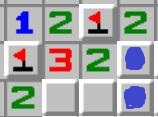Most Common Basic Patterns
To apply a pattern, one side of the number must not have any unopened squares.
Initially, assume there are no marked mines adjacent to the number. Scenarios with adjacent mines are covered later under the "Subtraction Principle."
"Edge" refers to the border of the board or an already revealed square.
(Unrelated numbers are hidden in the diagrams.)
1. A '2' on an edge has two adjacent mines.
 ,
,

2. Two '1's on an edge mean the three squares in the next column are safe.


3. A '1-2' pattern, regardless of position, indicates a mine in the third square.

4. A '3' surrounded by unopened squares has three adjacent mines.

5. In a '1-2-1' pattern, regardless of position, the two '1's have adjacent mines, and the '2' does not.

6. In a '1-2-2-1' pattern, regardless of position, the two '2's have adjacent mines, and the '1's do not.

These patterns apply regardless of horizontal or vertical orientation. Search online for more patterns.
Subtraction Principle:
1. If there are marked mines around a number, subtract the number of marked mines from the displayed number before applying a pattern.
For example, in the image below, the '3' has two adjacent marked mines (3 - 2 = 1), and the '2' has one adjacent marked mine (2 - 1 = 1). This simplifies to a 1-1 pattern, and the two dotted squares are safe to open.

2. Based on the subtraction principle, if one end of a series of unopened squares is next to a marked mine, treat it as an edge after subtracting the mine from the adjacent number, and apply the appropriate pattern.
To apply a pattern, one side of the number must not have any unopened squares.
Initially, assume there are no marked mines adjacent to the number. Scenarios with adjacent mines are covered later under the "Subtraction Principle."
"Edge" refers to the border of the board or an already revealed square.
(Unrelated numbers are hidden in the diagrams.)
1. A '2' on an edge has two adjacent mines.
 ,
,

2. Two '1's on an edge mean the three squares in the next column are safe.


3. A '1-2' pattern, regardless of position, indicates a mine in the third square.

4. A '3' surrounded by unopened squares has three adjacent mines.

5. In a '1-2-1' pattern, regardless of position, the two '1's have adjacent mines, and the '2' does not.

6. In a '1-2-2-1' pattern, regardless of position, the two '2's have adjacent mines, and the '1's do not.

These patterns apply regardless of horizontal or vertical orientation. Search online for more patterns.
Subtraction Principle:
1. If there are marked mines around a number, subtract the number of marked mines from the displayed number before applying a pattern.
For example, in the image below, the '3' has two adjacent marked mines (3 - 2 = 1), and the '2' has one adjacent marked mine (2 - 1 = 1). This simplifies to a 1-1 pattern, and the two dotted squares are safe to open.

2. Based on the subtraction principle, if one end of a series of unopened squares is next to a marked mine, treat it as an edge after subtracting the mine from the adjacent number, and apply the appropriate pattern.
Online HTML Minesweeper Game